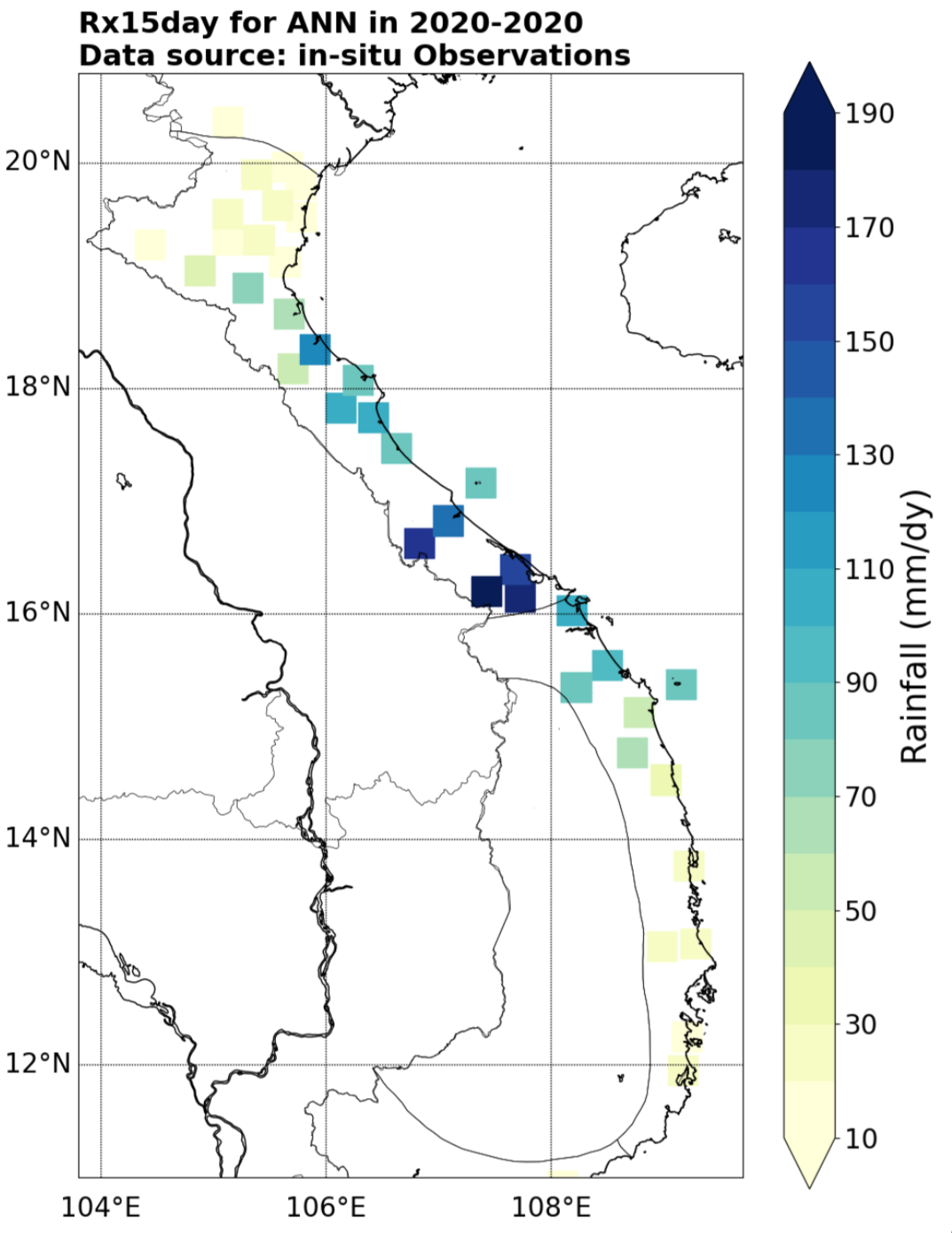Subsequently, typhoon Linfa struck the coast of Vietnam, followed by a tropical depression on 16th, again followed by two consecutive typhoons in the last week of October. The floods and landslides associated with these rainfall peaks caused more than 200 deaths and more than 500 people to be injured, with structural damage totalling approximately 1.2 billion US dollars.
Vietnam is one of the most hazard-prone countries in the world, and Central Vietnam in particular is susceptible to flood-generating tropical cyclones and other heavy precipitation events. Extreme daily rainfall in this region has been observed to increase along with global warming (Villafuerte and Matsumoto, 2015), which raises questions about a potential role of climate change in the events of October 2020.
Using peer-reviewed methodologies (Philip et al., 2020) we assess whether and to what extent human-caused climate change altered the frequency and intensity of 15-day heavy rainfall events (defined in this study as the annual maxima of consecutive 15-day precipitation, Rx15day, occurring within Central Vietnam).
Combining different lines of evidence we find no significant alteration of the likelihood of such events, which means that other risk factors and trends in those factors are important for disaster management and prevention. It is however important to highlight that Vietnam is a region that has been identified as a hotspot of compound flooding in the most recent IPCC AR6 report that is not well covered by observations.
Main findings
- Weather observations show that heavy rainfall (Rx15day) such as experienced in October 2020 is expected to occur about once every 80 years (at least once every 17) in today’s climate.
- According to the Vietnam Disaster Management Authority, the events from 6th – 20th October killed 138 people, with 16 people reported missing and 398 wounded. The events damaged more than 6200 homes beyond repair and submerged more than 375,000 houses. Flooding and landslides also devastated 167 km2 of crops, swept away 105 thousand tons of food and killed approximately 2.6 million cattle and poultry. Several hundred kilometers of canals, dams and roads were eroded and damaged. The losses and damages increased notably including 83 fatalities and missing people, many properties, roads, infrastructures and food destroyed after the strike of typhoon Molave at the end of October.
- Analysis of observations shows that the 1-in-80 year event of the current climate has been made slightly more likely to occur than in early-industrial climate by a factor of 1.6. However, the uncertainty around this factor is very large (0.1 to 400), so that it cannot be considered significant. This change corresponds to a 9% increase in rainfall amount, also with a large range of uncertainty from -41% to + 86%.
- To determine the role of human-caused climate change we undertake the same analysis using climate models that can adequately represent this type of heavy rainfall. These models show no change in the likelihood of an event at least as intense as the 2020 event, again with a large uncertainty range, from 2.5 times less to 2.3 times more frequent. No change in intensity was detected, with uncertainty from −8% to +8%.
- Combining results from models and observations, we find no significant evidence that human-caused climate change has changed the probability or intensity of the 2020 event.
- This null result is a reflection of the fact that changes due to climate change are currently much smaller than natural variability in extreme precipitation on the 2-week time scale. In fact, we repeat the analysis for annual maxima of 3-day and 7-day rainfall with a similar spatial definition, and find no discernible trend either.
- These results highlight that climate-change is not a major driver of present climate multi-day heavy rainfall over Central Vietnam. This implies that disaster risk reduction measures in this region need to be improved regardless of expectations of a changing climate.

Bibliography
Philip, S., Kew, S., van Oldenborgh, G.J., Otto, F., Vautard, R., van der Wiel, K., King, A., Lott, F., Arrighi, J., Singh, R. and van Aalst, M. 2020. A protocol for probabilistic extreme event attribution analyses. Advances in Statistical Climatology, Meteorology and Oceanography, 6(2): 177–203. doi: 10.5194/ascmo-6-177-2020
Villafuerte, M.Q. and Matsumoto, J. 2015. Significant influences of global mean temperature and ENSO on extreme rainfall in Southeast Asia. Journal of Climate, 28(5): 1905–1919. doi: 10.1175/JCLI-D-14-00531.1





